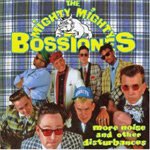Rock scenes don’t usually have a single saxophone-based band, but in the ’90s, Boston had two. The Mighty Mighty Bosstones’ pugnacious, goofy ska-rock was the polar opposite of the subtle, dangerous Morphine, but they both regularly sold out the Middle East in Central Square, and they both had modest radio hits.
The Bosstones, of course, also had a major hit -- 1997's “The Impression That I Get” -- but in ’92, they were only known primarily in Boston and Cambridge. That year saw the release of More Noise and Other Disturbances, the band’s second record and their first to downplay ska in favor of hard rock and punk. The horns/distortion combination was new at the time, and The Mighty Mighty Bosstones became credited with inventing the genre thereafter known as “ska-core” (a term cemented on the band’s covers EP, Ska-Core, The Devil and More).
It’s tempting to write off The Bosstones as a ’90s novelty, but the band’s best work -- including Disturbances and Question The Answers -- holds up surprisingly well. Though their punchy horns and dirty distortion acted as their calling card, it was only window dressing to the feisty but structured songs. “Awfully Quiet,” the leadoff track from More Noise and Other Disturbances, is as close as the band got to a thesis statement. “I like noise, that’s why I’m living where I am/ I like the noise and confusion of traffic jam,” says singer Dicky Barrett in the song’s first five seconds. The rest of the record supports this sentiment, from the raucous “Doctor D” (about the band’s rehearsal space below the titular doctor’s office) to “Guns And The Young,” whose refrain, “57 Magnum/ 9-millimeter handgun/ AK-47, and an uzi submachine gun,” is at first quietly chanted and then screamed.
Underneath this bombast, however, are the melodies that make these songs go down easy. “Where’d You Go” became a hit, and with good reason. It’s one of the band’s catchiest songs, and despite an angsty narrative -- the protagonist audibly shuts his car door and walks into his house, only to discover he’s been dumped -- the track is straight-up fun. Same goes for “It Can’t Hurt,” which starts with a peppy horn phrase and slips into the rumbling, punchy ska-pop that the band would later make famous.
There are a few missteps, such as the cringe-inducing “Bad In Plaid,” in which Barrett explains his band’s fashion choices. But it’s interesting to hear such a polished, digestible sound on an indie punk label, and even more interesting to hear a band on the verge of fame. Their next record, 1993’s Don’t Know How To Party, was on major label Mercury, and its successor Question The Answers would find the Bosstones at their most tuneful and focused. The rest of their story is typical rock fodder -- a huge hit, a disappointing follow-up, a casually announced hiatus, and periodic reunions.
At their peak, however, The Mighty Mighty Bosstones were the sound of pure pleasure, of giddily representing an also-ran city, of giving a shit in an age of grunge-induced stupor. More Noise and Other Disturbances’ final track is the epic “They Came To Boston,” in which a Hub lifer complains about the city's tourists and college students. The track includes a lyric that sums up the band perfectly: “I was here before they came, I’ll be here long after/ Don’t want to swear, but it seems clear that I’m gonna have to/ Awww, fuck.” The Mighty Mighty Bosstones treated organized chaos as an obligation, not a choice, a way to serve their city.
